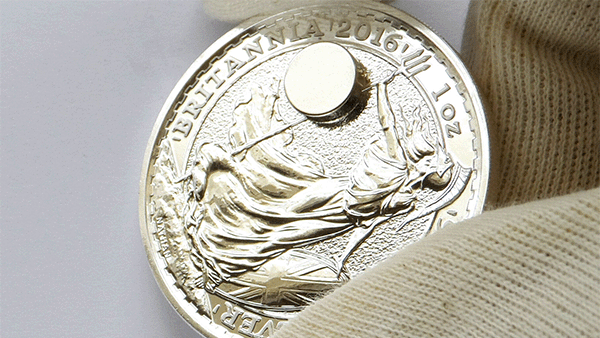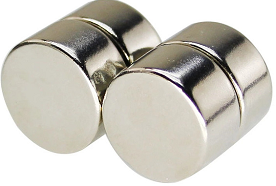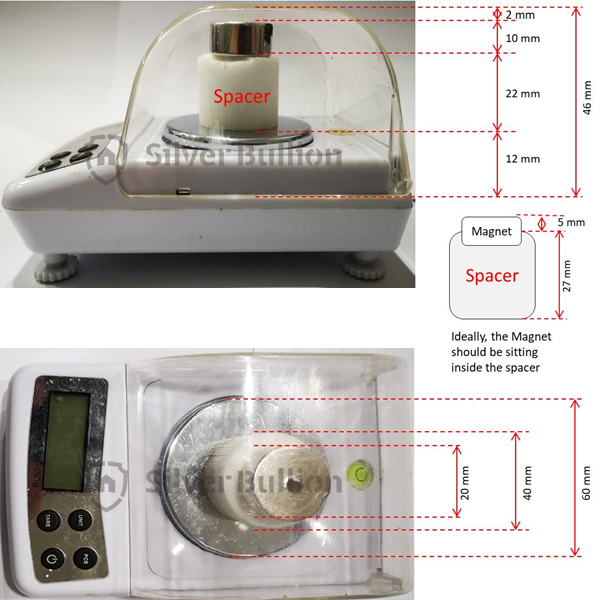Testing Gold & Silver With Magnets
11 April 2024

There are many ways to test whether a gold bar or a silver coin is genuine. Precious metal testing methods are broadly divided into two categories: destructive tests and non-destructive tests. Fire assays and acid tests are destructive tests, while common non-destructive tests include X-ray fluorescence, ultrasound tests, electrical conductivity measurements, and density tests.
Another non-destructive testing method for gold and silver is a magnet test. While certain testing methods like ultrasound tests and electrical conductivity measurements require expensive equipment, testing for fake gold or silver with a magnet test is much simpler and more cost-effective. However, testing precious metals with magnets should be accompanied by another testing method to achieve the most accurate results.
Magnetic Testing Principles and How It Works
Understanding Magnetism
Magnetism, like electricity and gravity, is a force of nature. It is exerted by magnets due to the motion of electric charges. These microscopic motions happen inside every substance as their electrons spin around atoms’ cores, generating an electric current and causing magnetism.
The strength of a substance’s magnetic field is dependent on the amount of electrons spinning in the same direction. Magnetism is canceled out if equal amounts of electrons spin in opposite directions.
Therefore, all materials have a degree of magnetism, with different magnetism strengths.
Types of Magnetism Relevant to Metals
Metals can exhibit various degrees of magnetism depending on their composition and structure. There are three main types of magnetism relevant to metals:
1. Ferromagnetism: This is the strongest type of magnetism and is exhibited by materials like iron, nickel, and cobalt. In ferromagnetic materials, the magnetic moments of individual atoms align in the same direction, creating a strong magnetic field. This alignment allows ferromagnetic materials to be attracted to magnets and to retain their magnetic properties even after the magnetic field is removed.
2. Paramagnetism: Paramagnetic materials are weakly attracted to magnets due to the alignment of their magnetic moments in the presence of an external magnetic field. Unlike ferromagnetic materials, paramagnetic materials do not retain their magnetization once the external field is removed. Most metals, including aluminum and platinum, exhibit paramagnetic behavior.
3. Diamagnetism: Diamagnetic materials are weakly repelled by magnets due to the induction of a magnetic field in the opposite direction to the applied magnetic field. Diamagnetism is a universal property of all materials and while diamagnetic effects are typically very weak compared to ferromagnetism and paramagnetism, they can still be observed in materials like copper, zinc, and bismuth.
Are Gold & Silver Magnetic?
Gold and silver are diamagnetic materials and are weakly repelled by magnets. Both precious metals do not have unpaired electrons in their outermost shells that spin to create a net magnetic moment. Therefore, gold and silver do not attract magnets and cannot be magnetized.
Ways to Test Precious Metals with Magnets
While the magnetism in gold and silver cannot be detected with weaker magnets like ferrites or ceramic magnets, its weak magnetic force can be detected with a rare earth magnet like the N52 Neodymium magnet.
Caution: Neodymium magnets are among the strongest commercially available magnets. They can attract ferromagnetic materials quickly with great force, which may cause injury if skin is caught between the magnet and the test object.

Magnetic Attraction
The simplest way to detect the presence of any ferromagnetic cores in fake bars or coins is to put them close to a strong magnet, like a neodymium magnet. If the test object is strongly attracted to the magnet, it is likely to be fake gold or silver.
This method is also useful for quickly testing jewelry and other gold items. Fake jewelry consists of small parts that are often plated with pure gold or silver. The presence of any metal beneath can be easily detected if the magnet sticks to the test object.
Magnetic Slide Test
The magnetic slide test is similar to the magnetic attraction test, but it reveals the nuanced behavior of gold and silver in relation to magnetism. There are two ways to perform the magnetic slide test.
The first method is more applicable to smaller objects like coins; it involves sliding a coin down a slide made of neodymium magnets. Objects with ferromagnetic cores will be attracted to the magnet and not slide down, while totally non-magnetic objects will slide off swiftly.
Gold and silver will move slowly down the slide due to their diamagnetic properties. However, other diamagnetic materials, like copper, will also exhibit a slower movement down the slide, making them difficult to differentiate from gold and silver to the untrained eye.
The second method is similar and is more applicable to larger objects like gold and silver bars. Instead of sliding the test object down a magnetic slide, the test object is held at an angle, and a small magnet is slid. The speed of the magnet’s slide is observed, much like how the speed of the test object is observed in the first method.
Magnetic Tester
One disadvantage of the magnetic slide test is that it is difficult to quantify the sliding speed of gold, silver, and other diamagnetic materials like copper. An untrained person may not notice the difference between the sliding speed of copper versus silver or gold.
The magnetic tester improves on the magnetic slide test, giving a quantifiable value to the magnetic susceptibility of test objects.
Our vault team has successfully experimented using a kitchen scale, spacer, and neodymium magnet. The setup is shown in the picture below.

The neodymium magnet rests on a non-magnetic spacer, which is meant to prop the magnet higher to ensure the test object is kept at a consistent distance from the magnet.
The scale is calibrated to net out the weight of the spacer and magnet, and its digital reading should show zero.
In the example below, we are testing the authenticity of two American Silver Eagle coins, one genuine and the other fake.

When we place the genuine Silver Eagle coin on the scale’s lid above the magnet, the digital scale gives a positive reading. This is because pure silver, being diamagnetic, repels the magnet, pushing it down on the scale.
The digital scales give a negative reading when we do the same with the fake silver coin. In this instance, the fake coin has a ferromagnetic core that attracts the magnet, lifting the magnet away from the scale.

Our tests have shown that this simple magnetic tester setup can test bullion coins rather quickly, even if the coins are kept in their mint-original plastic tubes.
Limitations of Magnetic Testing
While magnet tests are especially useful in detecting fake gold and silver bullion with magnetic and non-magnetic cores, they are unable to guarantee the authenticity of diamagnetic test objects when used as a single testing method.
For example, a magnet test is useful in detecting gold-plated tungsten bars, as tungsten is paramagnetic, exerting a noticeable greater magnetic attraction. Therefore, while a density test may not accurately reveal the tungsten’s presence due to its similar density to gold, a magnet test will highlight the obvious difference in magnetic susceptibility.
However, a magnetic test may not be conclusive when testing between silver and lead, both diamagnetic metals. The table below shows the properties of the two metals.
| Metal | Density (g/cm³) | Magnetic Susceptibility (x 10−5) | Celerity (m/s) | Electrical Conductivity (MS/m) |
| Silver | 10.49 | -2.6 | 3650 | 61.35 |
| Lead | 11.34 | -1.8 | 2160 | 5 |
The similarities between the densities and magnetic susceptibility of silver and lead may cause inconclusive density and magnetic test results. Rather, conducting an additional ultrasound test or electric conductivity measurement test would be better, given the larger difference in the measured values.
Therefore, precious metal testing should not rely on a single test method; a minimum of two tests should be used to provide greater accuracy in ascertaining real gold and silver.
The Safe House Also Performs Magnetic Tests
Since its inception in 2014, The Safe House has performed magnetic tests on countless precious metals entering the vault’s premises. We employ magnetic testing alongside other non-destructive precious metal testing methods, such as ultrasound tests, X-ray fluorescence (XRF) tests, electrical conductivity measurement (ECM) tests, and density tests.
Our wealth of experience in testing gold and silver has made The Safe House one of Asia's leading precious metal testing centers.